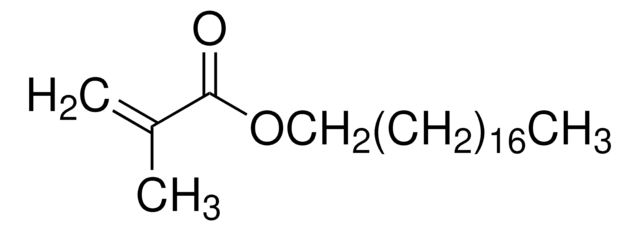Kluczowe dokumenty
291811
Lauryl methacrylate
contains 500 ppm MEHQ as inhibitor, 96%
Synonim(y):
Dodecyl 2-methyl-2-propenoate, Dodecyl methacrylate
About This Item
Polecane produkty
Poziom jakości
Próba
96%
zawiera
500 ppm MEHQ as inhibitor
współczynnik refrakcji
n20/D 1.445 (lit.)
bp
142 °C/4 mmHg (lit.)
mp
−7 °C (lit.)
gęstość
0.868 g/mL at 25 °C (lit.)
ciąg SMILES
CCCCCCCCCCCCOC(=O)C(C)=C
InChI
1S/C16H30O2/c1-4-5-6-7-8-9-10-11-12-13-14-18-16(17)15(2)3/h2,4-14H2,1,3H3
Klucz InChI
GMSCBRSQMRDRCD-UHFFFAOYSA-N
Szukasz podobnych produktów? Odwiedź Przewodnik dotyczący porównywania produktów
Powiązane kategorie
Opis ogólny
Zastosowanie
- To prepare polymeric co-stabilizer by free-radical copolymerization.
- To fabricate fluorine-less superhydrophobic cotton fabrics via graft polymerization process.
- In the synthesis of prepolymers that are used in oil absorbents.
Hasło ostrzegawcze
Warning
Zwroty wskazujące rodzaj zagrożenia
Zwroty wskazujące środki ostrożności
Klasyfikacja zagrożeń
Aquatic Acute 1 - Aquatic Chronic 1 - Eye Irrit. 2 - Skin Irrit. 2 - STOT SE 3
Organy docelowe
Respiratory system
Kod klasy składowania
10 - Combustible liquids
Klasa zagrożenia wodnego (WGK)
WGK 1
Temperatura zapłonu (°F)
224.6 °F - closed cup
Temperatura zapłonu (°C)
107 °C - closed cup
Środki ochrony indywidualnej
Eyeshields, Gloves, type ABEK (EN14387) respirator filter
Wybierz jedną z najnowszych wersji:
Masz już ten produkt?
Dokumenty związane z niedawno zakupionymi produktami zostały zamieszczone w Bibliotece dokumentów.
Klienci oglądali również te produkty
Global Trade Item Number
| SKU | GTIN |
|---|---|
| 291811-100ML | 4061826594308 |
| 291811-500ML | 4061837404917 |
| 291811-1ML | |
| 291811-5ML |
Nasz zespół naukowców ma doświadczenie we wszystkich obszarach badań, w tym w naukach przyrodniczych, materiałoznawstwie, syntezie chemicznej, chromatografii, analityce i wielu innych dziedzinach.
Skontaktuj się z zespołem ds. pomocy technicznej











